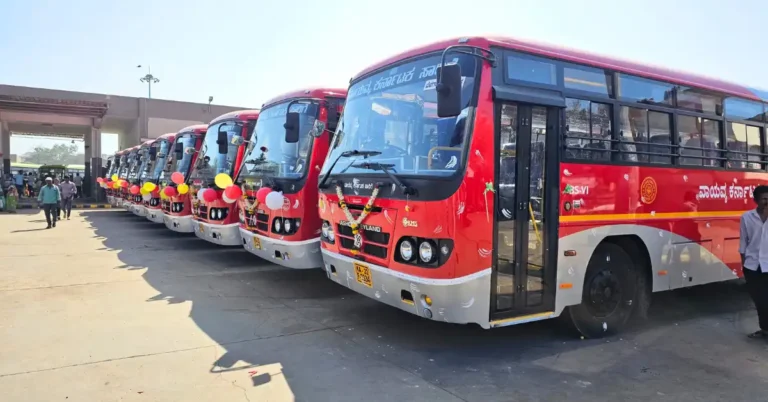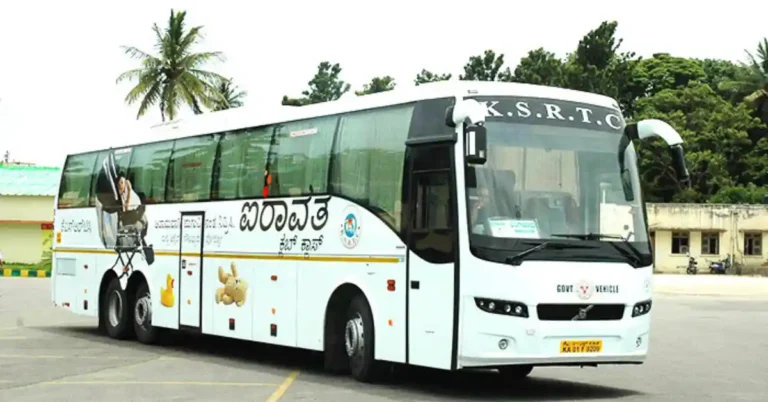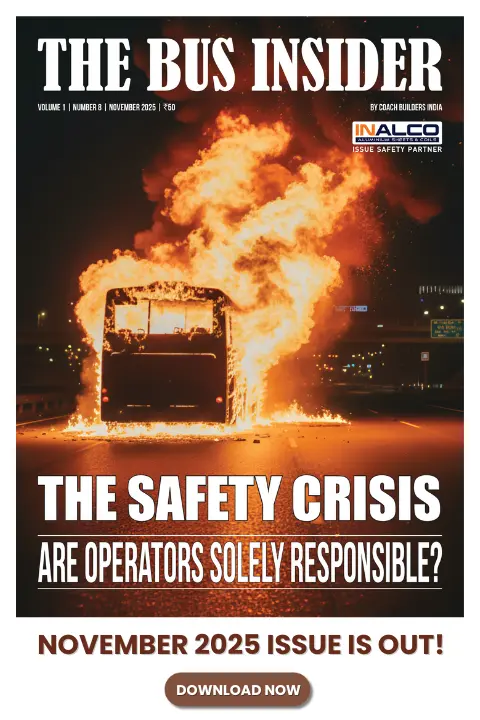Here’s How to Start a Bus Business in India: A Complete Guide
The most comprehensive guide available on the internet. We bring to you an experience-backed, step-by-step guide on how to start a bus business in India.
.webp?updatedAt=1754997434574)
Looking to enter India’s growing transportation sector? This guide helps aspiring entrepreneurs start their own bus business in India.
We’ll walk through the essential legal requirements, explain how to create a solid financial plan, and show you the basics of building and managing your bus fleet.
The Indian bus transportation market offers significant opportunities for new businesses that can provide reliable, comfortable service across urban and rural routes. Here’s what you need to know to get started.
Understanding the Bus Transportation Market in India
A. Analyzing current demand for bus services
The bus transport scene in India is booming. Over 70 million people use buses daily! That’s massive. And here’s the kicker – private operators control about 80% of this market.
People need buses for everything. Daily commutes, weekend getaways, pilgrimages, school runs, corporate transport – you name it.
City buses are always packed. Intercity routes see constant traffic. And tourist spots? They’re gold mines during season.
What’s driving this demand? Simple:
- Growing population (especially in tier-2 and tier-3 cities)
- Rising incomes but not everyone can afford cars
- Terrible traffic making personal vehicles less appealing
- Improved highways making bus travel faster
B. Identifying profitable routes and niches
The real money is in finding those sweet spots others have missed. Look at these opportunities:
| Route Type | Profit Potential | Competition Level |
| Metro-to-Tourist spots | High | Medium |
| Inter-city business routes | Very High | High |
| Rural connectivity | Medium | Low |
| Corporate employee transport | High | Medium |
| School bus services | Steady | Medium |
Focus on routes connecting emerging business hubs. Or try luxury overnight services between major cities. Many operators ignore semi-urban routes – big mistake!
C. Studying competition and market gaps
The giants like KSRTC, UPSRTC, and private players like SRS Travels dominate certain routes. But they can’t be everywhere.
Gaps you can exploit:
- Luxury segment with premium amenities (most operators offer basic service)
- Tech integration (real-time tracking, easy booking)
- Women-only services for safety concerns
- Late night/early morning connectivity
- Specialized services for elderly/disabled passengers
Visit bus terminals. Take competitor rides. Talk to frustrated passengers. Their complaints are your business opportunities.
D. Understanding seasonal variations in demand
Timing is everything in this business. Miss these patterns and you’ll be running empty buses:
- Summer months: Tourist travel peaks, especially to hill stations
- Monsoon: Overall travel dips except emergency/essential travel
- Festival seasons: Massive surge in hometown travel
- Wedding seasons: Group bookings spike in November-December and April-May
- Competitive exam periods: Student travel increases
Smart operators adjust their fleet deployment seasonally. Some even change their entire business model with the calendar – running tourist services in peak season and switching to corporate/school contracts during off-seasons.
The real pros develop a mixed portfolio of routes to balance these fluctuations.
How to attach your bus in redBus in 2025? A step-by-step guide
Legal Requirements and Permits

A. Obtaining commercial vehicle permits
Getting your bus on the road legally starts with permits. You’ll need to grab a commercial vehicle permit from your Regional Transport Office (RTO). The process isn’t a walk in the park, but it’s doable:
- Fill out Form 46 (Application for Permit)
- Provide your business registration documents
- Submit vehicle registration papers
- Include driver’s licenses for all drivers
- Pay the permit fees (varies by state)
Processing time? Usually 2-4 weeks. Don’t try shortcuts here – operating without proper permits can get your business shut down before it even starts.
B. Understanding Motor Vehicle Act regulations
The Motor Vehicle Act is your rulebook. Miss these regulations and you’re asking for trouble:
- Mandatory vehicle fitness certificates renewed annually
- Driver qualification requirements (minimum experience of 3 years)
- Passenger safety norms
- Pollution control standards
- Speed governor installation (mandatory for commercial vehicles)
The Act gets updated regularly, so stay on your toes. Join a transport association to get updates on new regulations.
C. Route permit acquisition process
Want to run on specific routes? You need route permits:
- Submit application to State Transport Authority
- Specify exact routes and stops
- Attend public hearing (competitors might object)
- Pay route-specific fees
- Renew every 3-5 years
Popular routes are competitive. Consider starting with underserved areas where permit approval is easier.
D. Insurance requirements and options
Skimping on insurance is plain stupid. You need:
- Comprehensive commercial vehicle insurance
- Passenger liability coverage (minimum ₹5 lakhs per passenger)
- Third-party insurance (mandatory)
- Driver and staff insurance
Compare policies from multiple providers. The cheapest option rarely gives the coverage you actually need when accidents happen.
E. GST and tax compliance
Tax headaches can sink your business fast:
- Register for GST (mandatory for interstate services)
- File quarterly GST returns
- Maintain trip-wise revenue records
- Pay state passenger tax (rates vary by state)
- Keep fuel expense receipts for input tax credits
Hire a specialized transport business accountant. They’ll save you more money than they cost by finding legitimate tax breaks specific to the bus industry.
Business Structure and Financial Planning
A. Choosing the right business entity (Proprietorship vs Partnership vs Company)
To start a bus business in India, you need to choose the right business structure. The business structure you pick will impact everything from taxes to your personal liability. Let’s break down your options:
| Business Entity | Pros | Cons |
| Proprietorship | • Simple to set up • Complete control • Less paperwork • Direct tax filing | • Unlimited personal liability • Limited funding options • Business ends with owner |
| Partnership | • Shared investment burden • Combined expertise • Easy formation | • Shared liability • Potential conflicts • Dissolves if partner leaves |
| Private Limited Company | • Limited liability protection • Professional credibility • Easier to raise capital • Perpetual existence | • Higher compliance requirements • More expensive to set up • Complex taxation |
Most serious bus businesses go for Private Limited Company status. Yeah, there’s more paperwork, but the liability protection alone is worth it when you’re running vehicles on public roads.
B. Creating a detailed business plan
Your bus business plan isn’t just paperwork—it’s your roadmap to success. Include:
- Executive Summary: Your business concept in a nutshell
- Market Analysis: Who needs your bus service? Why?
- Service Description: Routes, frequency, vehicle types
- Competition Analysis: Other bus operators in your target areas
- Marketing Strategy: How you’ll attract passengers
- Management Structure: Who’s running this show
- Financial Projections: 3-5 year outlook including:
- Revenue forecasts
- Operational costs
- Break-even analysis
- Cash flow statements
A solid plan isn’t just for you—it’s what banks and investors will scrutinize when deciding whether to fund your venture.
C. Estimating startup costs and operational expenses
The numbers don’t lie—bus businesses require significant upfront investment:
Startup Costs:
- Fleet acquisition: ₹30-80 lakhs per bus (new) or ₹15-40 lakhs (used)
- Permits and licenses: ₹50,000-2 lakhs, depending on routes
- Insurance: ~₹1-1.5 lakhs per bus annually
- Garage/depot space: ₹20-50 lakhs (purchase) or ₹30,000-1 lakh monthly (rent)
- Office setup: ₹2-5 lakhs
Operational Expenses:
- Fuel: ₹20-30 per km per bus
- Driver salaries: ₹15,000-30,000 monthly per driver
- Maintenance: ₹1-2 lakhs per bus annually
- Taxes and permit renewals: ₹50,000-1 lakh annually
- Marketing: 5-10% of revenue
Build a buffer—unexpected costs always pop up.
D. Securing funding and investment options
Finding the cash to get rolling:
- Self-financing: The simplest but requires substantial personal capital.
- Bank Loans: Most common for transport businesses. Typically covers 70-80% of vehicle cost with 5-7 year terms. Interest rates hover around 10-15%.
- NBFC Financing: Companies like Shriram Transport Finance or Tata Motors Finance specialize in commercial vehicle loans.
- Government Schemes: Check MSME loans and transport department subsidies.
- Private Equity: For larger operations, bringing in investors can provide capital in exchange for ownership stakes.
- Leasing Options: Lower initial outlay but higher long-term costs.
Remember—lenders want to see skin in the game. Be prepared to put up 20-30% of the total project cost yourself.
Fleet Acquisition and Management
.webp?updatedAt=1754997725613)
A. New vs used bus purchasing considerations
You’re standing at a crossroads. Fine! You have decided to start a business in India, but what will you start with – new buses with that sweet factory smell or used ones with stories to tell?
Both have their place in your business plan.
New buses cost more upfront (₹25-80 lakhs depending on size and type) but come with warranties, better fuel efficiency, and the latest safety features. Your passengers will notice the difference, and you’ll spend less time dealing with breakdowns.
Used buses? They’re budget-friendly, often 40-60% cheaper than new ones. But here’s the catch – maintenance costs will creep up on you, and they might not meet the latest emission standards.
Quick comparison:
| Factor | New Buses | Used Buses |
| Initial Cost | High (₹25-80 lakhs) | Lower (₹10-30 lakhs) |
| Maintenance | Minimal for first 2-3 years | Potentially high |
| Financing | Easier loans, better terms | Limited options |
| Passenger Appeal | Higher | Lower |
| Resale Value | Better | Poor |
Pro tip: If you’re just starting, mix both. One new bus for premium routes and a couple of well-maintained used buses for regular routes.
B. Leasing options for beginners
Cash-strapped but ambitious? Bus leasing might be your ticket to getting started.
Leasing requires less upfront capital—typically just 3-6 months’ security deposit compared to the full purchase price. You’ll pay monthly, keeping your cash flow healthy while you build your business.
Two main options in India:
- Operating lease: Pay monthly, hand the bus back when done. Great for testing routes.
- Finance lease: Similar to buying on installments with ownership transfer at the end.
Most lessors in India offer 3-5 year terms with maintenance packages. Companies like SRTU Financing, Shriram Transport, and some manufacturers themselves have programs specifically for bus entrepreneurs.
The math usually works out if you’re running regular routes with predictable income. A 40-seater AC bus might cost ₹40,000-60,000 monthly on lease versus a ₹35 lakh purchase.
C. Fleet size planning based on routes
Planning your fleet size isn’t about ego, it’s about efficiency.
Start by mapping your routes thoroughly. A 100km intercity route needs different considerations than a 15km city shuttle.
Here’s a simple calculation:
Required buses = (Daily passengers × Average journey time) ÷ (Operating hours × Seating capacity × Load factor)Most successful startups begin with 2 buses per route plus one backup. This gives you flexibility without overcapitalizing.
For intercity routes, factor in turnaround time. A Delhi-Jaipur route (5 hours each way) means one bus can only make one round trip daily.
City routes? You’ll need more buses, but smaller ones. School or corporate contracts often need dedicated vehicles that sit idle during off-hours.
D. Vehicle maintenance systems
Nothing kills a bus business faster than vehicles that don’t move.
Set up a three-tier maintenance system:
- Daily checks (30 minutes): Fluids, brakes, tires, lights
- Weekly inspections (2 hours): Deeper mechanical review
- Monthly overhauls (Full day): Comprehensive service
Create digital maintenance logs for each vehicle. Apps like TruckSuvidha or FleetIO work well for Indian operators.
Build relationships with authorized service centers, but also find a reliable local mechanic for minor fixes. The official guys might charge ₹2,000 for something your local guy does for ₹500.
Set aside 15-20% of your monthly revenue for maintenance. Yes, that much. Preventive maintenance costs less than emergency repairs and lost business from breakdowns.
Smart operators dedicate one staff member as a maintenance coordinator who schedules service during off-peak hours.
Homegrown & Ahead: How IntrCity SmartBus Is Building a New Standard for Intercity Travel in India
Operational Infrastructure Setup
A. Establishing bus terminals and stops
Getting your bus terminals right can make or break your business. Trust me, I’ve seen operators scramble because they didn’t plan this part well.
Your main terminal needs these basics:
- Covered waiting areas (nobody likes standing in rain)
- Clean restrooms (seriously, don’t skimp here)
- Ticket counters with clear signage
- Basic refreshment options
- Security personnel
For route stops, you’ll need to:
- Map high-traffic areas where people actually need transportation
- Get necessary permits from local authorities
- Set up visible signage at each stop
- Install simple shelters where possible
Want to save money? Partner with existing businesses near your stops. The local chai shop might welcome your customers if it means more business for them.
B. Setting up maintenance facilities
Your buses are money-making machines only when they’re running. A broken-down bus is just an expensive roadblock.
At minimum, your maintenance facility needs:
- Inspection pits or hydraulic lifts
- Basic diagnostic equipment
- Parts inventory system
- Service scheduling software
- Trained mechanics (not just any mechanic—bus systems are unique)
Smart operators set up a preventive maintenance schedule:
| Maintenance Type | Frequency | What’s Checked |
| Daily check | Before first trip | Fluids, brakes, lights |
| Weekly service | Every 7 days | Tires, battery, filters |
| Major service | Every 10,000 km | Engine, transmission, suspension |
C. Implementing ticketing systems
Gone are the days of paper tickets and manual bookkeeping. Your ticketing system needs to handle:
- Online and mobile bookings
- Seat selection
- Multiple payment methods
- Cancellations and refunds
- Peak pricing adjustments
Most small operators start with ready-made solutions like RedBus integration or similar platforms. As you grow, consider developing your own app—it’s not just for tickets but becomes a marketing channel too.
Set up a simple customer database from day one. Tracking who travels where and when will be gold for your marketing later.
D. Creating scheduling and route management systems
The backbone of your operation is knowing exactly where each bus should be at any given time.
Start with these route planning basics:
- Map optimal routes based on road conditions and traffic patterns
- Calculate realistic travel times (add buffers for monsoon season)
- Identify peak demand periods for each route
- Schedule driver shifts to comply with safety regulations
Software options range from simple spreadsheets to specialized fleet management systems. Most operators find the sweet spot somewhere in between.
E. Developing safety and emergency protocols
The harsh reality? Bus accidents happen. Your response systems determine whether they’re minor incidents or business-ending disasters.
Your safety protocol should include:
- Driver qualification and regular testing
- Vehicle safety inspection checklists
- Emergency contact procedures
- First aid kits on every bus
- GPS tracking for all vehicles
- Clear procedures for breakdowns and accidents
Train every staff member—not just drivers—on emergency protocols. Run drills. Make safety part of your company culture, not just a rulebook gathering dust. The operators who survive long-term in this business aren’t just the ones with the newest buses—they’re the ones who handle emergencies like professionals
Staff Recruitment and Training
A. Hiring qualified drivers with proper licenses
Finding good drivers is make-or-break for your bus business. Don’t cut corners here!
First, verify their credentials. Look for:
- Valid Heavy Vehicle License
- At least 5 years of commercial driving experience
- Clean driving record with minimal traffic violations
- Medical fitness certificate
Where to find them? Try online job portals like Naukri.com, but don’t overlook offline recruitment through transportation unions and referrals from existing drivers.
Interview them thoroughly. Ask about their experience handling emergencies, their knowledge of routes, and how they’ve handled difficult passengers in the past.
B. Recruiting maintenance and support staff
Your buses need care from people who know what they’re doing. For maintenance staff, look for:
- Diploma/certification in automobile engineering
- Experience with commercial vehicles
- Knowledge of preventive maintenance
Support staff should include ticket collectors, cleaners, and office administrators. Each role needs specific skills, but all need reliability and customer service orientation.
C. Training programs for customer service
Good service keeps passengers coming back. Your training should cover:
- Professional communication with passengers
- Handling complaints and difficult situations
- Safety protocols and emergency procedures
- Route knowledge and timing adherence
Run monthly refresher courses. Use role-play scenarios and real passenger feedback in your training.
D. Developing staff retention strategies
Keeping good staff saves you money and headaches. Try these proven approaches:
- Competitive salary packages with performance bonuses
- Health insurance and accident coverage
- Clear growth paths within your company
- Driver comfort amenities at terminals
- Recognition programs for exceptional service
- Regular feedback sessions to address concerns
The bus industry has high turnover. Stand out by treating your team well, and they’ll treat your passengers well too.
Mayank Kukreja on Guru Ram Dass Body Builders’ Growth and Evolution
Marketing and Customer Acquisition
Building a strong brand identity
Standing out in the bus business isn’t just about having nice vehicles. You need an identity that passengers instantly recognize and trust.
Start with a memorable name and logo that reflect your values. Are you focusing on luxury travel? Safety? Affordability? Your branding should scream this message.
Colors matter too. Think about major bus companies – they all have distinctive color schemes that help you spot their buses from a distance.
Your staff uniforms, ticket design, and even the interior of your buses should align with your brand. If you’re promising a premium experience, everything from your seat covers to your website needs to look high-end.
And don’t forget your brand voice. The way you communicate in ads, announcements, and customer service interactions should be consistent. Friendly and casual? Professional and formal? Pick one and stick with it.
Implementing digital marketing strategies
The bus business may be traditional, but your marketing shouldn’t be.
Create a mobile-friendly website where customers can check routes, timings and book tickets. Make sure it loads fast – nobody’s waiting around for a slow site when they need to catch a bus.
Social media is your friend. Post updates about new routes, share behind-the-scenes content of your maintenance procedures (safety sells!), and respond quickly to customer questions.
Google My Business is non-negotiable. When someone searches “bus to Mumbai,” you want your company popping up with accurate info.
Consider running targeted ads on Facebook and Google. You can zero in on people searching for transport in your service areas.
Email marketing works wonders too. Send special offers to previous customers – maybe a discount on their return journey?
Creating loyalty programs for regular travelers
Regular commuters are your bread and butter. Treat them right.
Set up a simple point system – every journey earns points that convert to free trips or upgrades. Nothing builds loyalty like getting something for free.
Monthly passes with decent discounts will lock in committed customers. Offer different tiers based on frequency of travel.
Surprise occasional perks work magic. Free snacks on certain days, priority boarding for loyalty members, or special seating options can make regular travelers feel valued.
Birthday offers are always a hit. Send a special discount code for trips booked during their birthday month.
Track data carefully to personalize offers. If someone travels the same route every weekend, send them deals specific to that journey.
Establishing corporate and school transportation contracts
Long-term contracts provide stable income that’ll keep your business afloat during slow seasons.
Approach companies with a tailored pitch. Highlight how your service can solve their employee transportation problems while saving them money on parking infrastructure.
Schools need reliable, safe transportation. Showcase your safety records, driver training programs, and vehicle maintenance schedules. Parents and school administrators obsess about safety – prove you do too.
Offer flexible contract terms initially to get your foot in the door. Once you’ve proven your reliability, you can negotiate better terms.
Create custom reporting for institutional clients. Schools want to know exactly when buses arrived and departed. Companies want data on usage patterns.
Don’t forget the tender process for government contracts. These can be bureaucratic nightmares but often lead to stable, long-term arrangements worth the initial hassle.
Technology Integration for Business Growth
.webp?updatedAt=1754997458245)
Many would argue that the points discussed below are not immediate requirements. They are not wrong. However, there is a difference between professionals and amateurs. If you are doing this seriously, you got to walk the professional way.
A. Implementing GPS tracking systems
Gone are the days of manually tracking your bus fleet with phone calls and guesswork. GPS tracking is a game-changer for bus businesses in India.
Most bus owners I talk to save 15-20% on fuel costs after installing GPS systems. Why? Because they catch drivers taking unauthorized detours or idling too long and sometimes even diesel thefts.
A basic GPS setup costs ₹5,000-10,000 per vehicle, but the ROI happens fast. Your customers will love the real-time tracking too – no more anxious waiting, wondering where their bus is.
B. Developing mobile apps for ticket booking
Your competitors already have apps. Do you?
A simple booking app can transform your business overnight. Our client Rajesh launched his basic bus booking app last year and saw bookings jump 35% in just three months.
Your app doesn’t need to be fancy – just functional. Focus on:
- Easy seat selection
- Multiple payment options
- Ticket cancellation features
- Simple interface for older users
A basic app costs between ₹30-40,000 (Android) depending on features. If that’s too steep, start with integrations on existing platforms like RedBus or AbhiBus.
C. Using data analytics for route optimization
The difference between profitable and struggling bus businesses? Smart route planning.
With basic analytics tools, you’ll identify:
- Peak travel times by day/month
- Most profitable routes
- Underperforming schedules
- Seasonal demand patterns
I’ve seen operators increase revenue by 25% just by shifting departure times based on data. Tools like Tableau or even Excel can help you analyze simple patterns.
D. Adopting ERP systems for business management
Running a bus business means juggling maintenance schedules, staff rosters, ticket sales, and finances. Without an ERP system, you’re working harder, not smarter.
Good bus business ERPs handle:
- Vehicle maintenance tracking
- Driver scheduling and compliance
- Accounting integration
- Inventory management
BusOps and FleetMinder are good starting options priced for small to mid-sized operations. Start with core modules and expand as you grow.
Want to Enter the Bus Business? Think Twice – Says Chintan Rathod of Nakoda Travels
Embarking on Your Bus Business Journey
.webp?updatedAt=1754997472942)
Starting a bus business in India requires careful planning across multiple fronts—from understanding the market landscape and securing proper permits to establishing your business structure and building operational infrastructure.
Equally important are strategic decisions about fleet acquisition, staff training, and implementing effective marketing strategies to attract customers. Technology integration serves as a crucial element for efficiency and growth in today’s competitive transportation sector.
Your success in the Indian bus transportation industry depends on balancing regulatory compliance with customer-centric service delivery.
By focusing on quality fleet management, well-trained staff, and leveraging digital solutions, you can build a sustainable business that meets the growing mobility needs across India. Take the first step today by conducting market research and connecting with industry associations to gather valuable insights for your new venture.
Catch the latest Bus Industry updates, Exclusive Interviews, Bus News, and International Bus News on Coach Builders India. Download the latest issue of the The Bus Insider magazine for more insights.







